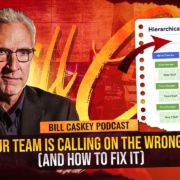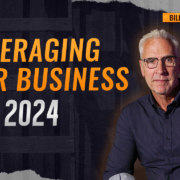How to Get Prospects to Sell You

No matter what anyone says, I don’t believe salespeople go into business so they can act desperate.
It’s true, if you think about it – most people in sales are there to do the right thing. Earn a living, provide for their family, secure their future. It’s not like they wake up thinking, “How will I intimidate someone into buying from me today?”
Now, I get it. We want to start selling, lickety-split. It’d be nice to start closing sales on Day One. Especially if you’re not out to hurt anyone. It’s time that can mess with our heads. The clock is ticking, and good time management is usually part of winning in sales. Think end of the month deadlines, life cycle of leads, and so forth.
I hate to be the one to tell you, but sales operates like marketing and follow-up. Many people need to hear things a good eight to twelve times before magic happens. If you let anxiety or impatience get the better of you, good intentions won’t matter. You need to send a sincere, patient message to your audience. Over and over.
Being in a hurry to sell sabotages your approach. Prospects want a calm, confident professional. Instead, they get a desperate, pushy salesperson. This is because the majority of communication is nonverbal. The sooner you understand that, the sooner you can adjust to send the right signals.
Heart for Sale
Our intentions and motives come from deep within. They’re based on what we believe. That’s common sense, right?
But as we know our intentions affect our actions. You’d think most people would connect them together. But common sense … isn’t all that common.
What’s interesting is salespeople notice this easily when they’re buying from another professional. But as soon as they get back in the seller’s chair… they forget all about it.
What difference would it make if you showed up differently? How would it look? You’d walk into a meeting where the only outcome that matters is serving the other person. Educating them. Solving their problems. Taking their side, instead of trying to push through their defenses.
It would send out vibes that the prospect could sense. They’d know just from the tone of your voice and the gleam in your eye. This changes everything.

The Lows and the Highs
There are people who only care about meeting a quota so they can earn commission. Do you think prospects can smell that? Of course. These are what I call “low-intent salespeople.”
They sell only for themselves. They don’t really care about the prospect. It’s a surprise if they even ask questions about the problem. They’re usually in a rush to get signatures.
High-intent salespeople, meanwhile, are in it for everyone. Of course, they want to succeed, but not at the expense of serving the customer.
High-intent salespeople also maintain healthy concern for their company. They regard sales calls as “interviews” to see if accepting the client solves problems for their firm.
High-intent salespeople also maintain healthy concern for their company. They regard sales calls as “interviews” to see if accepting the client solves problems for their firm. Click To TweetThe Best Intent = The Best Result
In most sales training, “results” usually means “more money for us.” Let’s flip the switch a little on this, to include process, focus and role reversal.
1. Process
The first thing high-intent selling changes is the overall experience of buying. It begins with marketing. On social media, blogs or anywhere else, are you generous with what you know? Can prospects take a few steps in the right direction, before you need money?
What about your funnel? Do you switch from soft marketing to a hard sell, or do you make time to give comfort to your prospect? Your first call should include a second dose of free knowledge they can use. The conversation should allow them to “brush up against you” and get a feel for you as someone they trust.
To close with high-intent, you need to be even more careful. Every call can have a blind corner or “misread signal” for the seller. How do you handle objections? Can you play with resistance, without being offensive? Can you reflect back to the prospect gently, applying pressure when it’s called for?
The salesperson who masters these subtleties of persuasion is a true champion. These are the ones clients later write to say, “Thank you for giving me the push I needed.”
2. Focus
If you’ve never watched a skilled journalist, you might want to pay attention to how they work. Celebrities give interviews to Barbara Walters, Howard Stern and Oprah Winfrey because they know they’ll be led into deep conversations – with millions of people watching.
Unlike salespeople, journalists don’t want money from guests. They want something far more important to the prospect … their story! Their background, pains, sorrows, hopes and aspirations. Don’t you think your prospects have stories? What if you’re competing for a piece of business their current vendor is neglecting? In your sales strategy, learn to think like a journalist.
A Word About Detachment
I recommend detachment as part of high-intent selling. But some people hear that and think it means, “Be passive.” Nope. Not at all.
The best definition for detachment is never being more interested in making the sale than the customer is in solving their problems. You are mindful of their pain, but you insist on remaining helpful rather than coercive.
It’s hard to frighten a salesperson who displays calmness, whether or not they actually make a sale. With high-intent selling, you remove pride from the equation and become preoccupied with serving the needs of the person in front of you..
Benevolent detachment sends a message to people: You are totally unafraid of them saying “No.” And that is exceedingly rare among salespeople.
3. Role Reversal
High-intent sellers usually end up being “sold” by their prospects. They radiate confidence and plenty of curiosity. They could be mistaken for “The Most Interesting Man (or Woman) in the World.” People insist on doing business, just because they find you interesting.
Some global companies “brand” with their audiences well. High-intent selling is a form of branding, graphic design and flashy logos or not. What people get from it is a feeling. If your prospects feel the difference, they need less persuading than normal.
Take it from me, you want to know what this feels like. The kind of sales conversations you’ll have will make it all worthwhile.
I don’t know if you’re intrigued with this. If you are, I invite you to my website to learn more about The 2X Group. It’s a mastermind we’ve created for sales professionals to help them do exactly what I’ve laid out in this article.
Click here to learn more about The 2X Group.







